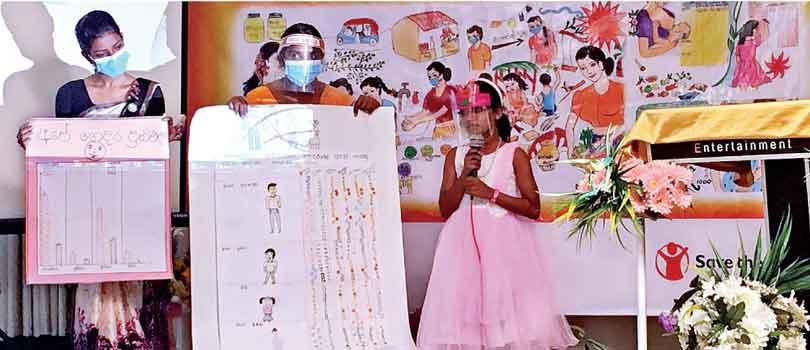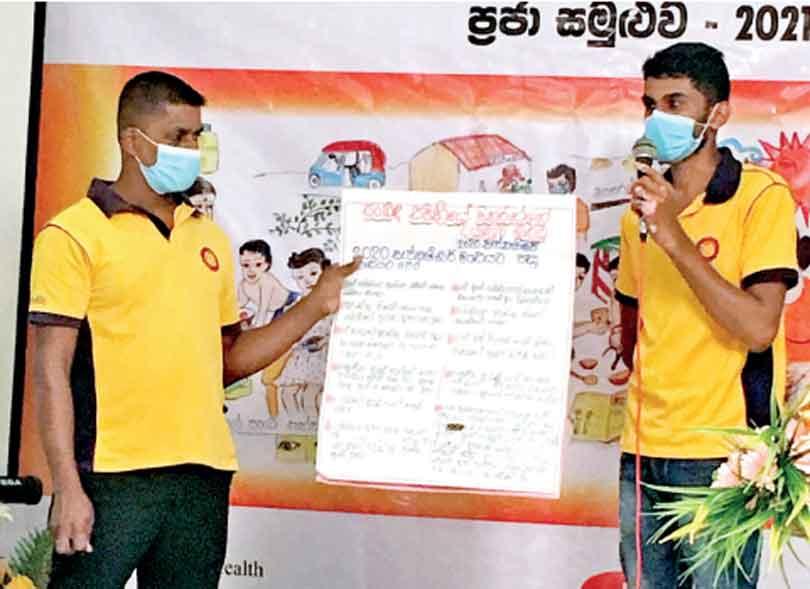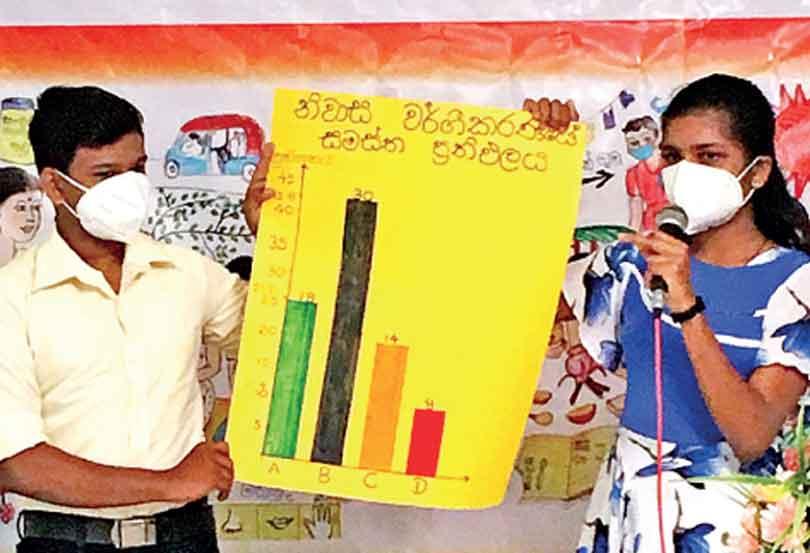Reply To:
Name - Reply Comment
 At a recently concluded Community Health Symposium in Morawaka many participants shared their experiences in implementing health promotion approaches at home and at community level
At a recently concluded Community Health Symposium in Morawaka many participants shared their experiences in implementing health promotion approaches at home and at community level
 Two years ago, communities in the small tea estate sector in Morawaka were introduced to several Health Promotion approaches. This was an initiative by the Health Promotion Department at the University of Rajarata. What resulted was a shift in behaviours and attitudes of these people. Nutrition being one of the key issues in the area was addressed in a way that made people realise the importance of shifting to healthy eating habits and nutrition practices. As such, mothers, children and youth were trained to not only implement these approaches, but also continue them and monitor the progress. Two years later, children, mothers and youth are continuing the process with their own creativity and concepts. At a recently concluded Community Health Symposium in Morawaka many participants shared their experiences in implementing health promotion approaches at home and at community level.
Two years ago, communities in the small tea estate sector in Morawaka were introduced to several Health Promotion approaches. This was an initiative by the Health Promotion Department at the University of Rajarata. What resulted was a shift in behaviours and attitudes of these people. Nutrition being one of the key issues in the area was addressed in a way that made people realise the importance of shifting to healthy eating habits and nutrition practices. As such, mothers, children and youth were trained to not only implement these approaches, but also continue them and monitor the progress. Two years later, children, mothers and youth are continuing the process with their own creativity and concepts. At a recently concluded Community Health Symposium in Morawaka many participants shared their experiences in implementing health promotion approaches at home and at community level.
“This project focuses on making a change at the field level by appointing groups and ensuring that an attitudinal change is happening. We observed changes in physical improvements and especially their attitudes. This is the biggest achievement,”
- Dr. Upali Karunaratne, Regional Director Health Services, Matara
“Save the Children has shifted itself from larger service delivery to become an organization of technical services and provide strategic and policy reforms, advocacy initiatives to the government. Service delivery is happening by the government but the biggest challenge is how to do these programmes effectively,”
- Julian Chellappah, National Director, Save the Children
Attitudinal changes - the biggest achievement

“If we take Kotapola, Pasgoda and Morawaka, there are certain concerns with regard to the nutritional indicators,” said Dr. Upali Karunaratne, Regional Director Health Services, Matara. “But in order to restore nutrition-related issues, there needs to be a multi sectoral approach. This project focuses on making a change at the field level by appointing groups and ensuring that an attitudinal change is happening. We observed changes in physical improvements and especially their attitudes. This is the biggest achievement. Poverty, lack of education are main reasons why people don’t follow best practices with regard to nutrition.” said Dr. Karunaratne.
Speaking about its continuity, Dr. Karunaratne said that MOH and PHM officers have been appointed at the field level apart from Mother Support Groups. “Even midwives have the experience to contribute to this process,” he said.
He further said that NCDs such as diabetes, hypertension prevail in these areas and risk factors such as smoking and obesity are common. “However, communicable diseases such as leptospirosis are common in these areas,” he added.
Technical guidance to bridge the gap
The programme is supported by Save the Children which provides technical assistance. “We finished a three year project with the Ministry of Health looking at health and nutrition status of mothers and children in the tea industry,” said Julian Chellappah, National Director, Save the Children, recalling how the programme came to life. “This gave us an idea about the tea industry and we presented it to GSK in a forum and they proposed if we could do the same programme in these areas. Therefore we thought it’s good to test it in communities living in small scale tea estates and chose this area. Save the Children has shifted itself from larger service delivery to become an organization of technical services and provide strategic and policy reforms, advocacy initiatives to the government. Service delivery is happening by the government but the biggest challenge is how to do these programmes effectively. Some of the programmes we designed, piloted and tested to see if it could be taken to a national practice.” said Chellappah.
“The biggest challenge is that there’s a gap between the community and service delivery. The government feels that it needs to be close to the communities, but it might be challenged by its own capacities. Regular on the job training and bringing people for training is a challenge. Language too is a barrier. We have seen about 700 MOH midwives in the estates who don’t speak the language of the estate community. Therefore access, awareness, being part of the community is a challenge. We conducted a programme to train midwives to speak in Tamil. There were several case studies in these locations and the relationships changed between the community and midwives. They also have their own logistical challenges and how long Save the Children could do that is also in doubt.” said Chellappah.
“Save the Children also goes with a mandate and agenda to push development players to incorporate children’s rights into their plans. Listen to children, be accountable and allow children to participate. Children and youth too can make a difference,” he added.
Health promotion graduates ready

The presentations done by mothers, children as well as youth were proof of the changes that have taken place within the communities. Some initiatives have also addressed staying healthy during the pandemic as well. “The secret behind these changes is the health promotion approaches we introduced,” observed Dr. Duminda Guruge, Health Promotion Department Head at Rajarata University. “People have therefore started taking control over circumstances that govern their lives. This change doesn’t happen overnight. So over the past three years we have transferred these skills to the people. Promoting health and health promotion are two different concepts where the latter includes studying the principles and continuing the process. This needs a set of people who have mastered these skills,” said Dr. Guruge.
“People have therefore started taking control over circumstances that govern their lives. This change doesn’t happen overnight. So over the past three years we have transferred these skills to the people. Promoting health and health promotion are two different concepts,”
- Dr. Duminda Guruge, Health Promotion Department Head at Rajarata University
The doctor further said that the graduates produced by the Department have the experience as well as the necessary skill sets. “If recruited by NGOS or INGOs they will be able to fulfil the objectives. They have the knowledge about a vast spectrum of topics ranging from NCDs to infectious diseases, child protection, tobacco and alcohol prevention among others. Therefore by recruiting these graduates it will be added support to the existing healthcare cadre.” said Dr. Guruge.
He also extended gratitude to Prof. Diyanath Samarasinghe for introducing the health promotion concept and also thanked Dr. Karunaratne and Save the Children for extending their support to make this initiative a resounding success.